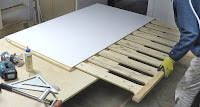Unlike
typical slide-out slat beds that have a fixed base, our bed platform is
vertically mobile and supported only on its front & rear sides by
the 2 'chopsticks'. Requiring it to be extremely rigid, so as not to miserably slump like a hammock when 2 humans are on board:
To prevent flexing, the bed platform was built using a stressed skin assembly. It consists of a 3/4" plywood sheet glued between two 1/4" plywood sheets:
The
sliding fingers of the sideway extension, were cut out of the 3/4"
sheet above, and sanded all around to facilitate the sliding:
A
sheet of white formica was glued on the underside, as shown in the pic
above. It will be the visible ceiling surface when the bed is tucked up
against the van's ceiling.
Note the 1" large rabbet
(3/16" deep) along the end of the platform, on the left side of the
pic. There is one on the other end too. Those will rest on the 1" lip
along the bottom of each chopstick.
Almost there. Time to see if jumping on it makes it flop like a fish out of the water...
Well, it is unbelievably rigid. I could not feel any flex !
Though,
it now begged the question whether 1/8" plywood sheets could have been
used instead of 1/4" ? That would have saved some weight and provided an
extra 1/4" of head clearance. No, stop that. Better
not get too distracted by endless tweaks... 😏
24" 150lbs linear actuators installed, with runways for the wires to the actuators and to the dining lights under the bed:
Sliding the extension by hand was very difficult as the slightest pull / push at an angle resulted in binding of the fingers. Likely due to the not-so-straight finger shapes from manually cutting with a jig saw, and from the rough texture of the plywood edges.
The binding was still slightly present after a lot of sanding and initially installing 2 actuators, as one actuator was taking ~2 more seconds than the other to fully deploy. Which could possibly worsen over time, depending on wear, lubrication aging, etc.
Dang it, can't have that. What to do: servo couple the actuators ? Cross feedback control their motion with hall sensors, lasers, GPS ?
Well, not being too smart, me thought 'If 2 no good, 3 iz better ?' 😏
So a 3rd actuator was added. Luckily that one was within a second of the other two. The fastest actuator got positioned in the middle, and this resulted in very smooth sliding with no sign of binding. Even over a full 24" course (only 20" is needed).
Total weight: 92lbs. Way more than the expected 50-60lbs, as the slide out fingers system was actually pretty light. But the 3rd actuator, sides, formica sheet and details added a lot of glue and weight.
Not optimal... Wyoming winds may have a chance at van tipping now ! 😅
____________________________________
>>> next post: Bed Motor Electricals & Success !
<<< previous post: Starship Chopsticks for the Bed !







Comments
Post a Comment